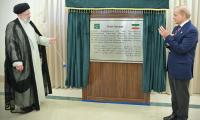The second half of the programme focused on the plight of native languages and asked if they were dying in Pakistan and what might be done to arrest that.
There was agreement that many languages were indeed under threat with a spectrum of opinion on what might be done. I suggested that allowing applicants to answer entrance tests in languages of their choice would help. It would signal a recognition of native languages and encourage competence in them. As a bonus, we would tap a talent pool that lacks mastery of English but could attain it if needed with an year of intensive immersion. Using English as a filter for selection makes little sense when access to it is so inequitable and its teaching so inadequate.
Native languages would also be boosted by mandating early childhood education in them, a practice with much supporting evidence. The real question is how to sequence the learning of languages and the transitions among them in a multilingual country like Pakistan. Again, there is no shortage of experience from studies on Mother Tongue-Based Multilingual Education. Such a switch would also set in motion the preparation of teaching materials in native languages.
There were inevitable remarks about the danger of our children being left behind if they do not begin their education in English from day one. This apprehension is refuted by the experience of countries using native languages for early education that have moved far ahead of Pakistan. For some reason this strange obsession refuses to go away.
There was also an interesting Darwinian perspective arguing that only the fittest languages would survive, except for the fact there has been so much intervention for and against languages that it can in no way be equated to a natural process. A contemporary example is the Single National Curriculum that arbitrarily favours Urdu over regional languages.
The discussion of Urdu triggered contrary perspectives. It was recognized as a link language although some challenged the need for one with the argument that people of different regions interacted with each other even before Urdu or English entered the subcontinent and would find a way of doing so again without the imposition of Urdu. With the quite different nature of interaction and mobility in present times this rejection of the need for a link language warrants more discussion.
Urdu was also labelled hegemonic for suffocating regional languages although this seems harsh since a language by itself cannot be hegemonic or have a religion for that matter going back to an earlier controversy. There are many in Pakistan not born to Urdu who speak and write it without feeling oppressed. Once again, Faiz can be cited as an example.
The above notwithstanding, Urdu has indeed been used for political purposes though without its acquiescence. The compulsion in Pakistan to concentrate power using language and religion has led to it being used as a tool despite the tragic fallout in East Pakistan. It is ironic that it is non-Urdu speaking elites that have misused Urdu for this purpose.
While recognizing the claim of regional languages for their rightful places, the above observation has interesting and sensitive aspects that merit attention if only for intellectual reasons. There is angst about the hegemony of Urdu among a certain subsection in Punjab but that does not seem to exercise the emotions of the majority – there hasn’t been a language movement on the scale of East Pakistan in the 1950s. Why that is the case is not obvious and worth exploring.
In this connection, there was a passing comparison with the alleged imposition of Persian in India by the Mughals. An aspect that bears reflection is that Persian was not the language of the Mughals so this cannot be classified as a case of linguistic nationalism. A plausible explanation could be that opting for any of the regional languages would have privileged one community over others – leading to resentment and strife. Persian was a neutral imposition that did not disadvantage any community disproportionately and left a level playing field. Granted the motives in Pakistan are nowhere as enlightened but in abstract terms the role of Urdu today could be considered comparable to that of Persian in Mughal India.
The generally complacent attitude towards Urdu in Punjab leads to broader questions about varying attitudes to language without passing any judgement on them. For example, the Kashmiri diaspora has almost entirely abandoned its language and adopted local dialects. In contrast, the Jewish diaspora has sustained and promoted its linguistic heritage. It was mentioned that the Sikh population in Pakistan has also transmitted Gurmukhi to succeeding generations.
Is it possible that languages or scripts that are the carriers of sacred texts, like Hebrew and Gurmukhi, have an advantage in this regard over others that are not, like Kashmiri and Shahmukhi? If true, left to its own devices Urdu itself might see a similar decline as a literary language. Its survival would depend only on its utility as a link language and for that purpose it would evolve as a mongrel of many languages, with English being the dominant one. That would be an ironic fate because Urdu came into being as a mongrel link language for communication. Its brief period of glory during the eclipse of Mughal rule was an accident of history and there is nothing now that can trigger a similar efflorescence.
I left the event with some clear conclusions: not much is to be gained by being emotional about languages nor by preserving them as museum pieces. Native languages need to be valued because they provide the best foundation for the cognitive development of children being the most readily accessible repositories of ideas and knowledge which makes them potent sources for creative expression. The displacement of native languages by English or Urdu filters out a huge talent pool and replaces it with a narrow elite that is inadequately equipped in any language and is therefore intellectually and aesthetically impoverished. This does not mean there is no place for Urdu or English. Every language adds value and additional ones can and should be learnt at the discretion of individuals to meet their needs and desires.
The event was a major contribution by the Institute of Art and Culture and THAAP, and more are needed to pursue the ideas that emerged during a long day that passed all too quickly because it was so enjoyable and exciting.
Concluded
The writer is a former dean of the School of Humanities and Social Sciences at LUMS.
An aeroplane of the national flag carrier of Pakistan is seen in this file photo. — AFPWhile Pakistan considers...
Representational image of a graph depicting various variables. — APP/FileInitiated by the centre and fiercely...
In this picture taken on April 16, 2023, people throng a market area during shopping in Lahore. — AFPOne of the...
Honour crimes also target men. In Sikandar Ali Lashari vs The State, SHC upheld conviction passed by ATC for honour...
If Sindh earmarks Rs20 million per police station, it will cost only Rs10 billion to make them effective first...
A complex and difficult policy environment seems to be highlighted by US’s recent application of sanctions on...







